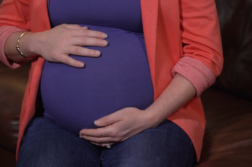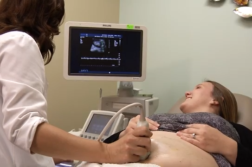HACKENSACK, NJ (Ivanhoe Newswire)— About 10,000 babies are born every day in the United States. One-third of those babies are delivered by C-section. Experts say a sharp increase in C-section deliveries over the past decade may be the top reason for the spike in pregnancy complications called placenta accreta spectrum, or PAS. Placenta accreta can cause excessive bleeding and be lethal for both mom and baby.
Four-year-old James is Elyse Lovett’s miracle. After delivering older brother William by C-section in 2014, Elyse became pregnant again a year later. This time, her baby’s placenta began growing too deeply into the uterine wall. It’s a condition called placenta accreta.
“You go online, and you read that there’s a 13 percent chance that you’ll die from this condition, that you’re gonna bleed out,” recalled Lovett.
Elyse sought out maternal-fetal specialist Dr. Abdulla Al-Khan, the Director of the Center for Abnormal Placentation.
“No mother should ever fear childbirth. I think that’s just wrong,” shared Dr. Al-Khan, MD.
Placenta accreta has quadrupled since the 1980s, going from one in 1,250 pregnancies, to one in 272. Doctors say previous C-sections are the number one risk factor for the condition. Dr. Al-Khan and his colleagues monitor women throughout their pregnancies, deliver babies by C-section, and then sometimes remove the uterus. While a traditional C-section usually takes forty minutes, these complex operations take several hours.
Dr. Al-Khan explained, “We were spending now, about eight to 12 hours, methodically dissecting everything, or perhaps doing staged surgical intervention.”
Dr. Al-Khan delivered James at 32 weeks, and repaired damage to Elyse’s bladder. Two months later Elyse was up and running.
“It’s such a precious gift to just be able to be with your child, hold your child, have a miracle child, and really say that you and your child are survivors and warriors,” expressed Lovett.
The National Accreta Foundation suggests mothers search out hospitals with maternal-fetal specialists having experience with placenta accreta, and neonatal intensive care units in case the baby needs specialized care after delivery.
Contributors to this news report include: Cyndy McGrath, Executive Producer & Field Producer; Kirk Manson, Videographer; Roque Correa, Editor.
To receive a free weekly e-mail on Medical Breakthroughs from Ivanhoe, sign up at: http://www.ivanhoe.com/ftk
Sources:
https://www.preventaccreta.org/placenta-accreta, https://www.cdc.gov/nchs/fastats/delivery.htm
https://www.preventaccreta.org/
https://www.preventaccreta.org/hospital
MEDICAL BREAKTHROUGHS
RESEARCH SUMMARY
TOPIC: PLACENTA ACCRETA: SAVING MOMS AND BABIES
REPORT: MB #4845
BACKGROUND: A serious pregnancy condition that occurs when the placenta grows too deeply into the uterine wall is known as placenta accreta. The placenta detaches from the uterine wall after childbirth, but with placenta accreta, part or all of the placenta remains attached which can cause severe blood loss after delivery. It’s also possible for the placenta to invade the muscles of the uterus or grow through the uterine wall. Placenta accreta is considered a high-risk pregnancy complication and if the condition is diagnosed during pregnancy, most likely an early C-section delivery will be scheduled followed by the surgical removal of the uterus, known as a hysterectomy.
CAUSES AND RISK FACTORS: There are often no signs or symptoms during pregnancy for placenta accreta except vaginal bleeding during the third trimester that may occur. Sometimes, it can be detected during a routine ultrasound. It is thought to be related to abnormalities in the lining of the uterus due to scarring after a C-section or other uterine surgery. If the placenta partially or totally covers your cervix or sits in the lower portion of your uterus, you’re at increased risk of placenta accreta. Placenta accreta is more common in women older than 35, and the risk increases as your number of pregnancies increases. A complication of severe vaginal bleeding can occur after delivery. The bleeding can cause a life-threatening condition that prevents your blood from clotting normally, as well as lung failure and kidney failure. A blood transfusion will be necessary.
CREATING A TREATMENT PLAN: It should be a priority when a patient is diagnosed with placenta accreta to create a treatment plan. Coordinate delivery to prevent the patient from experiencing life-threatening blood loss, which can occur if the patient suddenly goes into labor. A treatment plan is also helpful because it allows the patient to understand the effects of a hysterectomy and ask any questions that may arise. If a hysterectomy is not wanted by the patient, the surgeon may attempt to separate the placenta from the uterus. If the bleeding is not heavy, the surgeon can take out the section of the uterus attached to the placenta, or alternatively, remove some of the placenta and leave the parts that are attached to the uterus. However, about 40 percent of patients will start to bleed if those tissues are left inside.
FOR MORE INFORMATION ON THIS REPORT, PLEASE CONTACT:
MARY MCGEEVER
MARY.MCGEEVER@HACKENSACKMERIDIAN.ORG
If this story or any other Ivanhoe story has impacted your life or prompted you or someone you know to seek or change treatments, please let us know by contacting Marjorie Bekaert Thomas at mthomas@ivanhoe.com




